Abstract
Intelligent transportation systems use new technologies to improve road safety. In them, vehicles have been equipped with wireless communication systems called on-board units (OBUs) to be able to communicate with each other. This type of wireless network refers to vehicular ad hoc networks (VANET). The primary problem in a VANET is the quality of service (QoS) because a small problem in the services can extremely damage both human lives and the economy. From this perspective, this article makes a contribution within the framework of a new conceptual project called the Smart Digital Logistic Services Provider (Smart DLSP). This is intended to give freight vehicles more intelligence in the service of logistics on a global scale. This article proposes a model that combines two approaches—a Bayesian network and fuzzy logic for calculating the QoS in a VANET as a function of multiple criteria—and provides a database that helps determine the originality of the risk of degrading the QoS in the network. The outcome of this approach was employed in an event tree analysis to assess the impact of the system’s security mechanisms.
1. Introduction
The growth in freight transport due to the expansion of e-commerce and the globalization of industries and commercial exchanges has made logistics and transportation a vital segment of most companies in the competitive market [1]. However, transportation systems cause various safety and environmental issues. These issues include traffic-related noise, air pollution, and increased vehicle accidents. Most countries face the challenge of developing socioeconomic reforms that balance economic growth and environmental sustainability [2]. To achieve this balance, new concepts and technologies, such as radio frequency identification (RFID), robotics, and communication technologies, are used to maximize productivity and minimize costs and errors.
This work is part of the Smart DLSP research project (Smart DLSP is a big project registered in the Al Khawarizmi program launched in Morocco in May 2019). Its objective is to develop a collaborative Logistics 4.0 solution that improves process efficiency while reducing cost, effort, and errors. To achieve this goal, a carrier must be able to receive and process customer requests dynamically, regardless of logistical constraints. For that reason, a digital intelligent and decisional ecosystem (Ecodid) was created for the Smart DLSP. It aims to give each actor and each object (vehicles, road environments, goods, and warehouses) in the distribution chain an intelligent, collaborative, ubiquitous, and evolving character within a consolidation framework.
Adopting a vehicular network in Ecodid provides a high level of visibility, automation, control activities, and connectivity across the logistical environment and the entire supply chain. It can potentially improve delivery efficiency and economic factors for industries, as well as the service level for clients [3]. According to Barrat and Oke [4], in the commerce sector, there is a growing trend of organizations creating external relationships based on intercommunication in order to increase the visibility of their operations and activities.
Furthermore, by integrating new information technologies, e.g., sensors, edge computing, and artificial intelligence (AI), Ecodid seeks to develop the abilities of vehicles to exchange information with their environments, such as other vehicles, warehouses, and road infrastructure. This information can be shared with the whole system by using two wireless communication technologies: cellular networks and vehicular ad hoc networks (VANET).
This paper focuses on the VANET technology and, more specifically, intends to develop new techniques that guarantee good quality of service (QoS) for different applications. However, controlling all parameters that enable data transmission with specific QoS requirements is difficult in such environments. Accordingly, the approach proposed here combines two AI approaches to quantify the QoS in a VANET in order to ensure better functioning of ad hoc networks in general and for that relating to Ecodid in particular.
- The first approach uses Bayesian networks (BNs) to identify the factors that influence the QoS in a VANET.
- The second approach implements the fuzzy logic (FL) principle to compute the conditional probabilities (CPs) of all of the variables cited in the BNs.
The implementation of this approach involved the creation of a synthetic database that predicts risks associated with QoS in the VANET during transport. A fuzzy Bayesian model was created based on the construction of a probabilistic causal graph of the Bayesian network type, which was built from a significant set of parameters and their relationships. This graph allowed us to create CP tables by using fuzzy inferences in order to overcome the problem of the lack of data adapted to our study’s context. The resulting databases contained different combinations of possible situations for the occurrence of risks. Learning models can use them and make effective predictions, since they are based on fuzzy rules that were developed to reflect reality.
Afterward, event tree analysis (ETA) was adopted to handle the case of low QoS in a VANET in the presence of some blocking elements, which are also called reducing objects. This modeling analyzed the importance of security mechanisms in the prevention of communication problems in the system.
The rest of this article is structured as follows: Section 2 presents the related work. Section 3 explains the architecture of the fuzzy–Bayesian (FB) approach used in this work. Then, in Section 4, a case study is presented to demonstrate the feasibility and utility of the proposed model. Section 5 introduces the predictive management of low QoS in a VANET through the application of an ETA in an urban environment. The article ends with a conclusion that highlights future work.
2. Related Work
In a VANET, many applications are sensitive to latency and bandwidth constraints and have an epsilon tolerance for network interruptions. As a result, it must provide the best effort in terms of quality of service (QoS) to guarantee its performance [5]. The QoS aims to control network behavior and align the services according to user needs. In other words, it is the ability to provide different priorities to various applications that can satisfy a set of predetermined service constraints in terms of time, available bandwidth, packet loss, security, etc. [6].
Improving the QoS in a VANET is a hot research area and a very complex task because this type of network has special characteristics, such as high mobility, a lack of a centralized control unit, scalability, a hidden node issue, an insecure medium, and limited resources. Each author in the literature has treated this concept differently, and the majority of them have focused on the routing aspect.
On the one hand, some authors [7,8,9] chose to conduct comparative studies of existing routing protocols and algorithms. They aimed to select an efficient protocol that helped to improve different QoS parameters for various network scenarios, such as the delay, jitter, throughput, and packet loss ratio. Others developed new protocols, such as QMM-VANET [10], CBQoS-Vanet [11], and GeoQoE-Vanet [12]. The first is a clustering routing protocol that aims to maintain security and connectivity in the network. The second protocol also uses (i) clustering schemes to expedite the data transmission via cluster heads, and then (ii) implements an artificial bee colony to find the optimized route that satisfies both mobility and QoS metrics. The last one concerns a geographic protocol for video streaming. It strives for high quality in relaying vehicles through a correlated formula of quality-of-experience (QoE) and quality-of-service (QoS) factors. In an urban environment, the simulation results outperformed the Greedy Perimeter Stateless Routing (GPSR) and GPSR-2P protocols.
Deficiently, these studies only evaluated new protocols for particular scenarios; therefore, they did not consider the case of various types of environments with different density and mobility models.
On the other hand, many techniques were developed to improve the QoS within VANET. Some authors [13] used roadside units (RSUs) to collect and transmit traffic data via Dijkstra’s dedicated short-range communication protocol (DDSRC). This algorithm determines the shortest route to the destination based on the cost of each transmission path.
The authors of [14] invented new ways to improve a VANET’s performance by removing unused and useless packets. They perceived that the transmission of a large quantity of data in the network creates a queue of packets in the vehicle, which contributes to the expiration time of certain packets before being processed, thus causing a decreased service rate.
The authors of the following studies were interested in fuzzy logic mechanisms. The first proposed a fuzzy system for deciding on the most appropriate communication medium for running applications. The approach gathered information from the network and applications; then, it treated them using fuzzy rules. This system entertained several network-obtainable features that influenced the decision process, such as the network density, received signal strength, vehicle speed, and cost of service. The simulation results proved that the FL decision provided low packet losses, maintained a high packet delivery ratio, and offered a low latency in variable environments [15]. The second observed that to acquire an ideal QoS, it is necessary to ensure efficient and faster communication between nodes by resolving the problem of distorted network connectivity. The authors implemented a fuzzy logic approach to the level of node connectivity based on two criteria: the transmission range and the density of the nodes. The study assumed that improving the network connectivity could allow a VANET’s performance to be tweaked, and it stated that a better QoS could be reached under certain conditions (having less than 250 m in the transmission range) [16].
According to the research conducted, as summarized in Table 1, the studies presented above outlined aspects of the QoS in VANET in terms of routing, connectivity, or security. They focused on finding better mechanisms that satisfied only some QoS requirements and neglected some metrics. In conclusion, none of the previous solutions met all QoS criteria.

Table 1.
Summary of related works.
3. System Model
This section presents an overview of the FB approach, which combines FL theory and expert knowledge via BN modeling to facilitate risk prediction in complex systems. As shown in Figure 1, firstly, experts determined all of the parameters that could influence the degree of occurrence of risk. This identification led to the conception of the nature of the dependencies between the different events and the definition of the causal architecture of the Bayesian model. The experts also generated and determined fuzzy rules in order to use them to generate CP by deploying the FL system. This process was iteratively adopted to calibrate all fuzzy rules. In the end, the FB network was created out of the results of the fusion of the causal relationship graph and the CP calculated by the FL system. The remainder of this section clarifies the main components of this architecture.
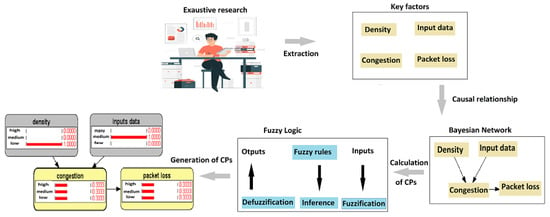
Figure 1.
The procedure for creating an expert-driven BN by using FL.
3.1. Bayesian Network
A Bayesian network (BN) is a probabilistic graphical model developed by Pearl to aid in reasoning under uncertainty [17]. A BN is defined by a pair (G, O), where G = V, A is a directed acyclic graph that encodes a joint probability distribution over a finite set of categorical variables V, and the arcs A represent direct relationships between them [18]. In addition, a set of parameters O defines the behavior of each variable caused by its parent in the graph.
The architecture of a BN is based on the identification of the relations between the nodes constituting the graph, which are divided according to their typology into three classes: input parameters ⇒ intermediate effects ⇒ final impacts
- The input parameters of the graph represent the input nodes of the network.
- Intermediate effects are direct effects that are broken down into the input parameters that are the origins of the causes.
- Final impacts are the factors that have a direct effect on the risk studied in the network.
3.2. Fuzzy Logic
To calculate different CPs, FL was selected due to its relevance for qualitatively assessing certain situations by using contextual understanding. It is a decision-making tool in cases of uncertainty where precise and reliable mathematical probabilities are lacking. It also formalizes imprecisions due to global knowledge of a very complex system and the expression of behaviors in natural language.
The implementation of FL for generating CPs was done in three principal steps [19,20]:
- Fuzzification converted the input variables into a fuzzy subset by using fuzzy linguistic values and membership functions.
- Inference evaluated and combined the fuzzy rules to form conclusions that gave the fuzzy outputs of the system.
- Defuzzification transformed the conclusions provided by the inference engine into numerical values, which represented the final response of the fuzzy system.
The Mamdani and Sugeno inference methods are the most popularly used. The principal difference between them is how the crisp output is inferred from the fuzzy inputs. Mamdani employs the defuzzification phase for fuzzy outputs, whereas Sugeno computes the result values by using a weighted average [21]. This study prefers the method of Sugeno because it has a faster processing time. As a result, the generation of CPs is achieved with just the two first steps.
4. Case Study
This section demonstrates the applicability of the method suggested in this work. Its first part presents an overview of the Smart DLSP project, which provides a general understanding of the factors influencing the QoS in VANET. The second explains the QoS model implemented in the proposed FB approach.
4.1. Overview of the Smart DLSP Project
The Smart DLSP project aims to provide an intelligent digital ecosystem to supply chain actors (e.g., producers, distributors, warehouse workers, retailers, and customers.). This ecosystem can offer various services and IT applications based on different technologies, as presented in Figure 2. It will also improve the quality and efficiency of supply chain activities and allow for enhanced freight management in the context of digital transformation, economic competitiveness, social considerations, and the respect for the environment within a logic of sustainable development.
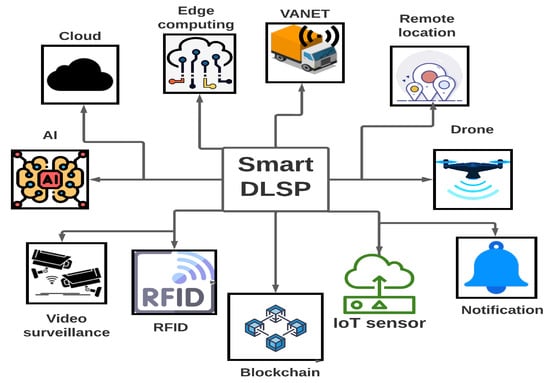
Figure 2.
Different technologies of the Smart DLSP.
The Smart DLSP needs to establish communication and circulate data among different network entities to have complete knowledge about the state of vehicles, warehouses, road quality, weather, and incident reports. This communication switches between two modes. The normal mode is used when there is an Internet connection, and the ad hoc mode is used when there are problems with the Internet. The normal mode has many advantages, such as an increased capacity, large coverage, and existing infrastructure. However, it can not fulfill the communication needs under some special conditions, such as at isolated sites and in areas after floods and tremors [22]. As a result, a VANET serves as a viable technology for communication and information storage, and it is simple to set up between neighboring vehicles at any time.
Figure 3 presents the proposed architecture. It consists of a local area network (A) with vehicles equipped with edge boxes. This latter collect data, process it locally and quickly, and exchange it with other vehicles or the system. Then, roadside units (RSUs) can be fixed along the road or in dedicated locations, such as parking spaces. They are equipped with network devices in order to extend the communication range of the ad hoc network by redistributing the information to other vehicles or RSUs. They can even provide Internet connectivity to road users via their connection to base stations [23]. Edge boxes are also installed in the warehouses (B) to manage data collected from diverse objects that are connected (IoT). Afterward, all accumulated data are translated into a standard message format and delivered by a performance messaging platform that is suitable for streaming (Cluster Kafka) within the cloud (C). Subsequently, the data streamed from the message brokers are aggregated, transformed, and structured by an ETL (extract–transform–load) platform, such as Apache Storm. The result can be an API call, an alert, an action, or a visualization. After the preparation of the streaming data, they are then ready to be analyzed to provide value through data analysis platforms and AI model building. Finally, the streaming data are stored in a data lake that will be accessible later for different users and vehicles.
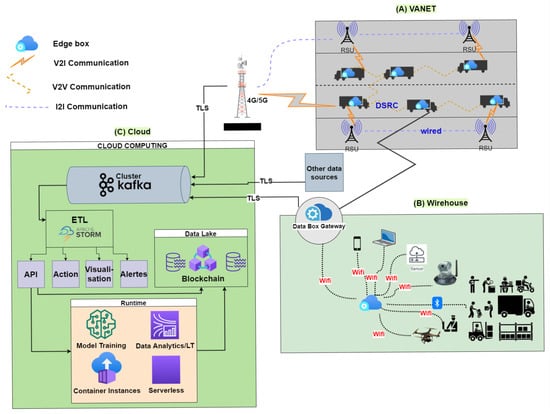
Figure 3.
Architecture of Ecodid.
Ecodid uses AI techniques to transform different networks’ vehicles into intelligent nodes that are capable of making brilliant decisions on their own to reach their destination in a reasonable time and with an acceptable cost. Ecodid can significantly improve the performance of logistical operations, such as by:
- Benefiting from many applications, such as traffic control and management, platooning, vehicle tracking, comfort applications, and different notification services [24].
- Having real-time tracking and tracing of vehicles and their loads to satisfy customer requests.
- Properly optimizing routes and empty returns.
- Respecting the constraints linked to a company’s activity, such as delivery times and schedules, and avoiding delays and errors in order delivery.
- Providing environmental protection by reducing unnecessary and non-optimized routes.
- Detecting the vulnerability of road transport and illegal activities (such as drug trafficking and stowaways).
- Providing preventive and reactive vehicle maintenance and risk management.
- Providing the possibility of using blockchain technology to authenticate vehicles, secure information exchanges, and financial transactions.
- Reducing road collisions and accidents.
- Improving drivers’ comfort and traffic efficiency.
- Providing real-time updates and payment accuracy for drivers and operators.
4.2. Application of the Proposed FB Approach
The main challenge for the Smart DLSP is that of building a supportive ecosystem that is capable of solving global logistics problems. This challenge cannot be reached without predicting the different risks that can degrade the QoS. As a result, it must have extensive knowledge of network architecture, including integrated electronic, computing, and wireless technologies. This section focuses on the analysis of the QoS in VANET technology for Ecodid. This analysis provides high visibility of the factors that can affect the project’s service fluidity. It will be implemented by following the steps below:
- Step 1:
- Application of a BN.
- Step 2:
- Calculation of the conditional probabilistic coefficients by using FL.
- Step 3:
- Calculation of the final output of the QoS in a VANET related to scenario examples.
4.2.1. Application of a BN
To model the QoS in a VANET for Ecodid, this study started with exhaustive research to identify the following main challenges of VANET:
- Risks related to influences on data routing from a route’s conditions, such as mobility, density of nodes, and road obstacles.
- Risks related to the security of the data circulated in the network due to external attacks and selfish behavior.
- Risks related to data processing that helps make decisions in different activities. This processing is affected by the quality and quantity of data collected from the different entities of the network.
This study also identifies all of the changing parameters that can influence the degree of occurrence of the above-mentioned risks. This identification led to the conception of the nature of the dependencies among the different events and the definition of the causal architecture of the Bayesian model. Table 2 describes all input variables affecting the QoS in a VANET, as presented in the graph in Figure 4.

Table 2.
Description of the input parameters affecting the QoS in a VANET.
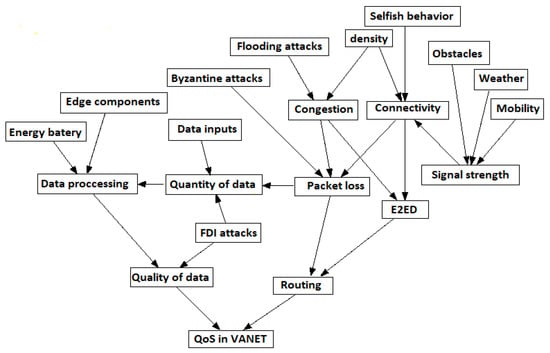
Figure 4.
BN modeling of the analyses of risk of QoS in a VANET.
4.2.2. Generation of Conditional Probabilities by Using an FL System
The first step in FL is to define the linguistic variables. This quadruplet (X, U, T(X), ) defines each one of them, where:
X is the name of the variable;
U is the universe of discourse associated with X;
is the set of linguistic values of the variable X;
represents the membership functions associated with the set of linguistic values.
Example:
The linguistic variable “congestion” is defined as follows: (X, U, T(X), ), where:
X represents congestion;
U: is the universe of congestion defined by the percentage.
The set T consists of three linguistic labels: low, medium, and high.
The membership function is represented by a Gaussian function, as shown in Figure 5.
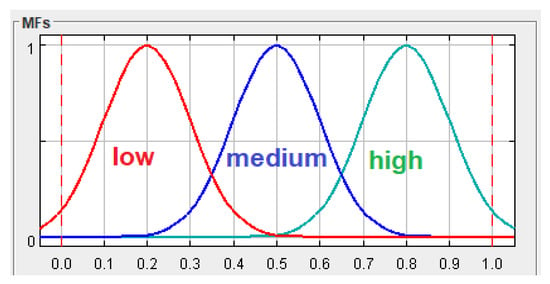
Figure 5.
Membership function for the “congestion” variable.
Table 3 presents all of the linguistic values of the fuzzy variables used in the BN.

Table 3.
Linguistic values of different variables of the Bayesian network.
After defining all of the linguistic variables, as explained in the preceding example, the next step was to create an FL inference system. For this reason, Sugeno’s method was implemented by using the FisPro software (more information is available on the FisPro website: https://www.fispro.org/en/ (accessed on 19 December 2022)). This allowed the complete design of a fuzzy inference system based on numerical data and expert rules related to the problem studied. According to the BN and information extracted in previous research, the fuzzy system incorporated 180 fuzzy rules, which produced 540 CPs. To illustrate this, we considered the degradation of service quality caused by channel congestion. This had three states (low, medium, and high) and two parents: “density” and “flooding attacks”. As a result, to calculate all different CPs for this variable as a function of its antecedents, the system would need nine fuzzy rules, as presented in Table 4.

Table 4.
Set of fuzzy rules for congestion.
After the use of the inference engine, the result of each rule is presented in Figure 6.
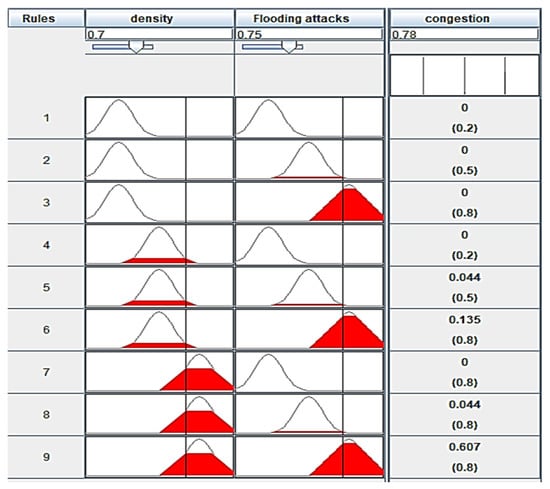
Figure 6.
Fuzzy inference of the “congestion” variable.
The next step aggregated different conclusions of the activated rules, as shown in Table 5, and combined them into a single value. This value was obtained through the union of all of the triggered conclusions, and it was translated by the max operator.

Table 5.
The activated rules of “congestion”.
The general conclusions for the variable “congestion” for the “medium” and “high” values were, respectively, and . However, the lowest value of was tolerated in the case in which the possibility was zero (here, for the “low” value), since each state of the variable “congestion” was possible, and this possibility had to be greater than zero.
- congestion (low) =
- congestion (medium) =
- congestion (high) = =
The sum of probabilities for each variable’s states had to be equal to 1. The CPs for the different states of the variable “congestion” for rule number 9 were calculated as follows:
| P(congestion = low ∣ density = high, flooding attacks = many) = |
| P(congestion = medium ∣ density = high, flooding attacks = many) = |
| P(congestion = high ∣ density = high, flooding attacks = many) = |
By following this approach, all CPs for the variable “congestion” for the different states of its antecedents were computed, as presented in Table 6.

Table 6.
CP table of the variable “congestion”.
4.2.3. Scenario Prediction and Result Interpretation
After building the BN and feeding it with different CPs by using the Open Markov software, three scenarios were studied for the prediction of the QoS in a VANET as a function of three various environments in which vehicles of the Smart DLSP could circulate.
Scenario 1: Urban Environment
On the one hand, a VANET in the urban environment, as presented in Figure 7, has good connectivity due to its high density and low mobility. However, this connectivity can be affected by obstacles such as tall buildings or vehicles that are not connected, which leads to frequent disconnection problems between edges [32]. Aside from this, VANET in these areas are prone to various attacks that could insert false data and disrupt the network’s functioning. On the other hand, there are enumerable attractive services, such as Internet access, automatic toll payment, traffic management, location-based services [33], and increased road events, such as accidents and criminal activity. These circumstances cause the data exchange to increase exponentially, which causes bandwidth congestion and saturation of edge components and battery energy.
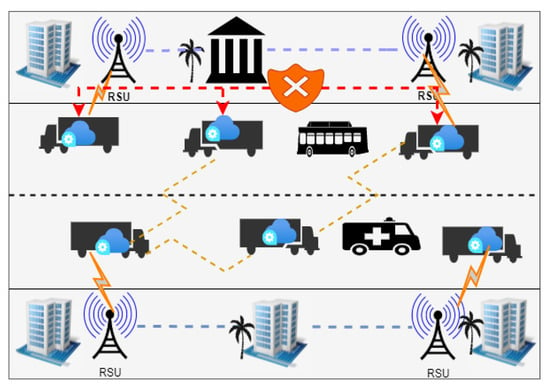
Figure 7.
A VANET in an urban environment.
Scenario 2: Rural Environment
Rural environments differ significantly from urban environments. The range provided by a VANET cannot cover the large inter-vehicle spacing resulting from the low density and poor infrastructure. In this scenario, the percentage of attacks was assumed to be very low, and the data exchanged did not cause any vehicle problems [34].
Scenario 3: Highway Environment
In general, highways have relatively adequate communication because most vehicles travel along the same path; additionally, in the absence of obstacles, signals propagate smoothly. However, the lifetime of links between vehicles is very short due to their high speed, which exceeds 100 km/h. In this scenario, a significant number of nodes are assumed to be selfish and deny participation in routing to save their own resources [35].
Table 7 presents the potential of each input node considered in the BN for the three scenarios described above. The inference system delivered the probability of propagation over intermediate effects and the final impacts to quantify the QoS in the VANET.

Table 7.
The potential of each input node considered in the BN for the three scenarios.
Figure 8 shows the result of the probability distribution for the QoS in the VANET for each scenario.
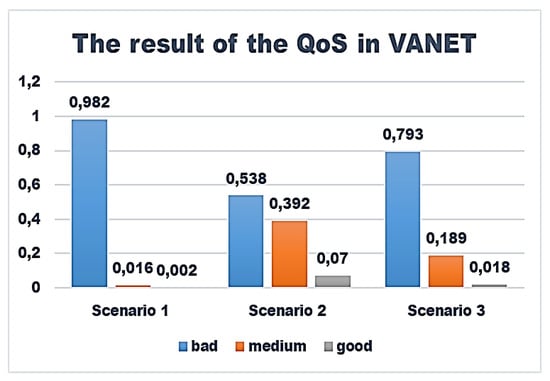
Figure 8.
The results of the QoS in the VANET.
Based on the results of the proposed FB approach for the three scenarios, it was concluded that the QoS in VANET in urban areas is more prone to weaknesses and vulnerabilities due to the high accessibility and congestion emanating from the increased traffic and delivery flows in cities. Knowing that, the QoS in VANET in this environment is the first interest of the Smart DLSP project, as the majority of companies are urban. In addition, poor management of transport operations by logistics providers leads to bad outcomes that affect the reputations of companies. The objective of the next section is to discuss the importance of using multiple technologies and security mechanisms together to overcome the problem of low QoS in VANET.
5. Predictive Management of Low QoS in VANET through the Application of Event Tree Analysis
5.1. Event Tree Analysis
Event tree analysis (ETA) illustrates the sequences of events related to a management’s success or failure by presenting different possibilities and probabilities on a tree structure, which is known as an event tree (ET). The tree is developed chronologically by studying the behavior of each element. Firstly, an initial event (IE) is predicted, and it is typically represented on the left as a horizontal line with vertical branches. Then, it is followed by intermediate events, which present controlled incidents with the aim of avoiding further danger [36].
5.2. Construction of the Event Tree
Figure 9 shows the event tree proposed for this study, which was built by following the steps described below:
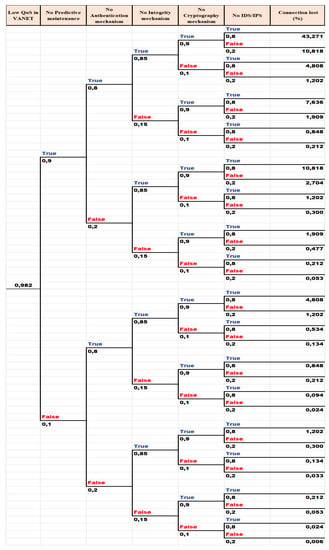
Figure 9.
Event tree presenting the probability of connection loss in a VANET related to the rate of functioning and success or failure of different security mechanisms.
- Identification of the initial event that is responsible for the critical situation of the system. In this study, this is the event of “low QoS in the VANET” for the urban environment case.
- Identification of intermediate events: The aim is to prevent the initial event or reduce its effects as much as possible. In this study, these events are a set of security mechanisms that limit the problem and avoid supply chain connection loss. They are:
- –
- Predictive maintenance;
- –
- An authentication mechanism;
- –
- An integrity mechanism;
- –
- A cryptographic mechanism;
- –
- Intrusion detection systems (IDSs) and intrusion prevention systems (IPSs).
- Identification of consequences: In this step, the expected consequences are defined after the end of each sequence of events.
- The tree’s quantification step consists of assigning probabilities for each branch that leads to the final result. This is calculated through the multiplication of each of branch’s probability as follows: , where = the set of branches that constitute the path to the outcome R.
5.3. Analysis of the Results
After presenting the event tree, it is easy to predict the probability of connection loss in the VANET related to the rate of functioning and the success or failure of different security mechanisms. According to the various existing scenarios, the rate of connection loss in the network is at its maximum (43.271%) if all of the security systems are not functioning correctly and is at its minimum (0.006%) otherwise. Consequently, this analysis shows the importance of equipping the system with security barriers that can limit the effects of the initial event. Furthermore, these outcomes can help evaluate the system’s acceptability and suggest improvements.
6. Conclusions
This article outlines the prediction of risks that negatively impact the QoS in VANET. Although this technology offers easy configuration and quick deployment, it is not without problems. This study introduced a symbiotic combination of a BN and FL to quantify the QoS in VANET. Furthermore, it showcases the results from three test scenarios that highlight the impact of varying the input parameters in the designed network. Finally, by applying ETA, the outputs of the FB model enabled us to predict the connection loss in a VANET in the presence of a set of security mechanisms, which could help to improve the performance of Ecodid in the case of bad road conditions and risks.
The FB approach has been used in many studies and domains—for example, in the ecological domain [37], medicine [38], logistics [39], and collision warning systems in VANET [40]. According to the above-mentioned research, the presented studies gave optimal solutions for the improvement of the QoS in VANET, but could only consider a few parameters simultaneously. However, in reality, where decisions have to be made based on several criteria, these approaches are insufficient. Unlike previous works, the work presented here analyzed the risks in a VANET and predicted the QoS by considering multiple parameters, which justifies its interest and its originality.
The limitations of the FB approach include its ability to incorporate all factors that affect the QoS in VANET. Incomplete consideration of input parameters can impact the accuracy of predictions. Furthermore, selecting appropriate fuzzy sets and assigning membership degrees can be difficult and is dependent on domain-specific knowledge and expertise, which can vary from person to person and from situation to situation, leading to potential biases in the model and inconsistent outcomes. Despite being a useful tool for modeling uncertainty in probabilistic reasoning, the FB approach must be used with caution and in conjunction with other methods to overcome these limitations.
This proposed approach can be used to address complex, uncertain and dynamic decision-making problems in real-world scenarios. This approach merges the advantages of both fuzzy logic and Bayesian probability theory, leading to more precise and reliable predictions compared to methods that only employ one of these approaches. Furthermore, the model is straightforward to understand, making it easier for practitioners to make informed decisions and to pinpoint areas for improvement through the examination of new inputs, membership functions or by combining this approach with other methods to enhance its predictions.
Future work will aim to minimize the subjectivity issue by employing objective criteria to determine the fuzzy sets and assign membership degrees. These criteria will incorporate real-time data, such as traffic, weather and Global Positioning System (GPS) data through appropriate methods, such as simulations and field trials. to provide more accurate predictions and timely decision-making support. Additionally, the use of deep learning methods will enhance the predictions and push the boundaries of the state-of-the-art in this field, tackling new and challenging problems. Furthermore, the security measures outlined in the event tree will also be examined in order to establish a secure digital ecosystem that can be leveraged for all intelligent transportation system projects.
Author Contributions
Conceptualization, H.K. and A.A.; methodology, H.K. and A.A.; software, H.K.; validation, A.A., A.F., and S.S.; formal analysis, H.K.; investigation, A.A. and A.F.; resources, A.A.; data curation, H.K.; writing—original draft preparation, H.K.; writing—review and editing, H.K. and A.A.; visualization, A.A., A.F., and S.S.; supervision, A.A. and A.F.; project administration, A.A.; funding acquisition, A.A. All authors have read and agreed to the published version of the manuscript.
Funding
This research received no external funding.
Data Availability Statement
All data has been present in main text.
Acknowledgments
This research was supported by the Ministry of Higher Education, Scientific Research, and Innovation, the Digital Development Agency (DDA), and the National Center for Scientific and Technical Research (CNRST) of Morocco (Smart DLSP Project—AL KHAWARIZMI IA-PROGRAM).
Conflicts of Interest
The authors declare no conflict of interest.
References
- Perkumienė, D.; Osamede, A.; Andriukaitienė, R.; Beriozovas, O. The impact of COVID-19 on the transportation and logistics industry. Probl. Perspect. Manag. 2021, 19, 458–469. [Google Scholar] [CrossRef]
- Organisation for Economic Co-operation and Development. Transport Logistics: Shared Solutions to Common Chalenges; OCDE: Paris, France, 2002; p. 52. [Google Scholar] [CrossRef]
- Khaliq, K.A. Role of VANET in Logistics and Transportation. Int. Grad. Sch. Dyn. Logist. 2017, 5, 47. [Google Scholar]
- Barratt, M.; Oke, A. Antecedents of supply chain visibility in retail supply chains: A resource-based theory perspective. J. Oper. Manag. 2007, 25, 1217–1233. [Google Scholar] [CrossRef]
- Sra, P.; Chand, S. QoS in mobile ad-hoc networks. Wirel. Pers. Commun. 2019, 105, 1599–1616. [Google Scholar] [CrossRef]
- Garg, A.; Kumar, A.; Chaturvedi, A.K. Analysing the Effects of Mobility Model on QoS in MANET. IJCA Dec. 2017, 975, 8887. [Google Scholar] [CrossRef]
- Srivastava, A.; Verma, S.; Jhanjhi, N.; Talib, M.; Malhotra, A.; Kavita. Analysis of Quality of Service in VANET. In Proceedings of the IOP Conference Series: Materials Science and Engineering, Kancheepuram, India, 22 April 2020; Volume 993, p. 012061. [Google Scholar] [CrossRef]
- Tabar, S.; Azadmanesh, A. Quality of service in vehicular ad hoc networks. In IAENG Transactions on Engineering Sciences: Special Issue for the International Association of Engineers Conferences 2016; World Scientific: Singapore, 2018; pp. 388–401. [Google Scholar] [CrossRef]
- Dorge, P.D.; Dorle, S.S.; Chakole, M.B.; Thote, D.K. Improvement of QoS in VANET with different mobility patterns. In Proceedings of the International Conference on Radar, Communication and Computing (ICRCC), Tiruvannamalai, India, 21–22 December 2012; pp. 206–209. [Google Scholar] [CrossRef]
- Fatemidokht, H.; Rafsanjani, M.K. QMM-VANET: An efficient clustering algorithm based on QoS and monitoring of malicious vehicles in vehicular ad hoc networks. J. Syst. Softw. 2020, 165, 110561. [Google Scholar] [CrossRef]
- Lakas, A.; Fekair, M.E.A.; Korichi, A.; Lagraa, N. A multiconstrained QoS-compliant routing scheme for highway-based vehicular networks. Wirel. Commun. Mob. Comput. 2019, 2019, 1–18. [Google Scholar] [CrossRef]
- Benmir, A.; Korichi, A.; Bourouis, A.; Alreshoodi, M.; Al-Jobouri, L. GeoQoE-Vanet: QoE-Aware Geographic Routing Protocol for Video Streaming over Vehicular Ad-hoc Networks. Computers 2020, 9, 45. [Google Scholar] [CrossRef]
- Parimala, G.; Nageswararao, S.; LakshmiNadh, K. DDSRC: Algorithm for improving QOS in VANET. Int. J. Recent Technol. Eng. (IJRTE) 2019, 7, 1327–1331. [Google Scholar]
- Sayadi, M.J.; Fathy, M.; Mahaki, L. Improving the Quality of Service in the VANET by Detecting and Removing Unused Messages. Int. J. Inf. Commun. Technol. Res. 2012, 4, 107–112. [Google Scholar]
- Bouali, T.; Senouci, S.M. A fuzzy logic-based communication medium selection for QoS preservation in vehicular networks. In Proceedings of the 5th ACM Symposium on Development and Analysis of Intelligent Vehicular Networks and Applications, Cancun, Mexico, 2–6 November 2015; pp. 101–108. [Google Scholar]
- Rathore, P.; Shrivastava, L. Network Connectivity Analysis of VANET using Fuzzy Logic Controller. Int. J. Appl. Eng. Res. 2018, 13, 9802–9806. [Google Scholar]
- Kitson, N.K.; Constantinou, A.C.; Guo, Z.; Liu, Y.; Chobtham, K. A survey of Bayesian Network structure learning. arXiv 2021, arXiv:2109.11415. [Google Scholar] [CrossRef]
- Scanagatta, M.; Salmerón, A.; Stella, F. A survey on Bayesian network structure learning from data. Prog. Artif. Intell. 2019, 8, 425–439. [Google Scholar] [CrossRef]
- Sattar, H.; Bajwa, I.S.; ul Amin, R.; Muhammad, J.; Mushtaq, M.F.; Kazmi, R.; Akram, M.; Ashraf, M.; Shafi, U. Smart wound hydration monitoring using biosensors and fuzzy inference system. Wirel. Commun. Mob. Comput. 2019, 2019, 8059629. [Google Scholar] [CrossRef]
- Pop, M.D.; Prostean, O.; David, T.M.; Prostean, G. Hybrid solution combining Kalman filtering with takagi–sugeno fuzzy inference system for online car-following model calibration. Sensors 2020, 20, 5539. [Google Scholar] [CrossRef]
- Rad, M.H.; Abdolrazzagh-Nezhad, M. Data Cube Clustering with Improved DBSCAN based on Fuzzy Logic and Genetic Algorithm: Designing and Improving Data Cube Clustering. Inf. Technol. Control 2020, 49, 127–143. [Google Scholar] [CrossRef]
- Bian, F.; Zhang, Y. Geospatial Information Service Based on Ad Hoc Network. Int. J. Commun. Netw. Syst. Sci. 2009, 2, 118–122. [Google Scholar] [CrossRef]
- Saggi, M.; Sandhu, R. A survey of vehicular ad hoc network on attacks and security threats in VANETs. In Proceedings of the International Conference on Research and Innovations in Engineering and Technology (ICRIET 2014), Kanpur, India, 1–2 August 2014; pp. 19–20. [Google Scholar]
- Ahamed, A.; Vakilzadian, H. Issues and challenges in VANET routing protocols. In Proceedings of the 2018 IEEE international conference on electro/information technology (EIT), Rochester, MI, USA, 3–5 May 2018; pp. 0723–0728. [Google Scholar] [CrossRef]
- Eli-Chukwu, N.C.; Onoh, G. Experimental study on the impact of weather conditions on wide code division multiple access signals in Nigeria. Eng. Technol. Appl. Sci. Res. 2019, 9, 3998–4001. [Google Scholar] [CrossRef]
- Afzal, Z.; Kumar, M. Security of vehicular ad-hoc networks (VANET): A survey. J. Phys. Conf. Ser. 2020, 1427, 012015. [Google Scholar] [CrossRef]
- Rehman, G.U.; Ghani, A.; Muhammad, S.; Singh, M.; Singh, D. Selfishness in vehicular delay-tolerant networks: A review. Sensors 2020, 20, 3000. [Google Scholar] [CrossRef]
- Cabelin, J.D.; Alpano, P.V.; Pedrasa, J.R. SVM-based detection of false data injection in intelligent transportation system. In Proceedings of the 2021 International Conference on Information Networking (ICOIN), Jeju Island, Republic of Korea, 13–16 January 2021; pp. 279–284. [Google Scholar] [CrossRef]
- Ali Alheeti, K.M.; Gruebler, A.; McDonald-Maier, K. Intelligent Intrusion Detection of Grey Hole and Rushing Attacks in Self-Driving Vehicular Networks. Computers 2016, 5, 16. [Google Scholar] [CrossRef]
- Krishnan, P.R.; Kumar, P.A.R. Detection and Mitigation of Smart Blackhole and Gray Hole Attacks in VANET Using Dynamic Time Warping. Wirel. Pers. Commun. 2022, 124, 931–966. [Google Scholar] [CrossRef]
- Porwal, V.; Patel, R.; Kapoor, D. An investigation of DoS flooding attack in VANET. Int. J. Adv. Found. Res. Comput. (IJAFRC) 2014, 1, 158–169. [Google Scholar]
- Paranjothi, A.; Khan, M.S.; Atiquzzaman, M. Hybrid-vehcloud: An obstacle shadowing approach for vanets in urban environment. In Proceedings of the 2018 IEEE 88th Vehicular Technology Conference (VTC-Fall), Chicago, IL, USA, 27–30 August 2018; pp. 1–5. [Google Scholar] [CrossRef]
- Velayudhan, N.C.; Anitha, A. Sybil attack in VANET operating in an urban environment: An overview. In Advances in Communication Systems and Networks; Springer: Singapore, 2020; pp. 433–442. [Google Scholar] [CrossRef]
- Zhang, M.; Wolff, R.S. Routing protocols for vehicular ad hoc networks in rural areas. IEEE Commun. Mag. 2008, 46, 126–131. [Google Scholar] [CrossRef]
- Shugran, M.A.A. Applicability of overlay non-delay tolerant position-based protocols in highways and urban environments for VANET. arXiv 2021, arXiv:2105.03517. [Google Scholar] [CrossRef]
- Raiyan, A.; Das, S.; Islam, M.R. Event tree analysis of marine accidents in Bangladesh. Procedia Eng. 2017, 194, 276–283. [Google Scholar] [CrossRef]
- Liu, K.R.; Kuo, J.Y.; Yeh, K.; Chen, C.W.; Liang, H.H.; Sun, Y.H. Using fuzzy logic to generate conditional probabilities in Bayesian belief networks: A case study of ecological assessment. Int. J. Environ. Sci. Technol. 2015, 12, 871–884. [Google Scholar] [CrossRef]
- Zarikas, V.; Papageorgiou, E.; Regner, P. Bayesian network construction using a fuzzy rule based approach for medical decision support. Expert Syst. 2015, 32, 344–369. [Google Scholar] [CrossRef]
- Bouhadi, O.E.; Azmani, M.; Azmani, A.; el ftouh, M.A. Using a Fuzzy-Bayesian Approach for Predictive Analysis of Delivery Delay Risk. Int. J. Adv. Comput. Sci. Appl. 2022, 13, 316–326. [Google Scholar] [CrossRef]
- Golestan, K.; Karray, F.; Kamel, M.S. High level information fusion through a fuzzy extension to multi-entity bayesian networks in vehicular ad-hoc networks. In Proceedings of the 16th International Conference on Information Fusion, Istanbul, Turkey, 9–12 July 2013; pp. 1180–1187. [Google Scholar]
Disclaimer/Publisher’s Note: The statements, opinions and data contained in all publications are solely those of the individual author(s) and contributor(s) and not of MDPI and/or the editor(s). MDPI and/or the editor(s) disclaim responsibility for any injury to people or property resulting from any ideas, methods, instructions or products referred to in the content. |
© 2023 by the authors. Licensee MDPI, Basel, Switzerland. This article is an open access article distributed under the terms and conditions of the Creative Commons Attribution (CC BY) license (https://creativecommons.org/licenses/by/4.0/).